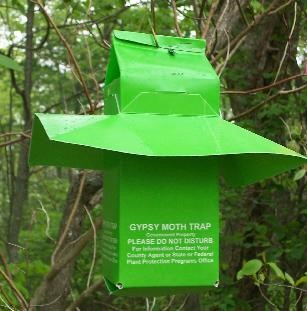Tree Health


Events
Dundas Cactus Festival / August 15 to 17
Volunteer
Hamilton Conservation Authority
Hamilton Naturalists’ Club
Green Venture
Citizen Science programs
Volunteer events
The City of Hamilton monitors tree pests and diseases and, when necessary, conducts management activities to protect our City trees and the overall health of our urban forest. Some tree diseases are not harmful to the host tree over the long-term, while other pests and diseases can spread rapidly and kill infected host trees leaving a devastating impact on entire communities.
Take action! Learn to identify invasive pests and diseases that impact trees and report your sighting using the below resources:
- Report an Invasive Pest Sighting to the CFIA
- Report an Invasive Species by calling 1-800-563-7711
- Report an Invasive Species on EDDMapS
Have you spotted an invasive pest or disease on a City-owned tree? Contact our Forest Health team at [email protected]
Pests & Diseases
Commitment to Inclusion As part of the City of Hamilton’s commitment to diversity and inclusion, the City has replaced the name gypsy moth with Spongy Moth in it’s communications to help educate residents about the invasive pest while remaining sensitive to the negative connotations associated with its common name.
Spongy Moth is an invasive forest pest that was introduced accidentally in 1869 to the United States. Since then, the Spongy Moth has expanded its range over much of the eastern United States and into Canada. It was first detected in Ontario in 1969 and has since spread across southern Ontario. It is now well established throughout southern Ontario and as far north as Sault Ste. Marie.
Spongy Moth larvae or caterpillars feed on tree leaves. If the larvae population is high, they can defoliate entire trees and forests in a short period of time. Spongy Moth prefer oak trees but will feed on a variety of hardwood tree species. Under normal circumstances, defoliation caused by Spongy Moth won’t kill a tree. However, trees can decline to the point of death when defoliation occurs during dry, hot summers or the trees are already impacted by other forest pests like Spring or Fall Cankerworm.
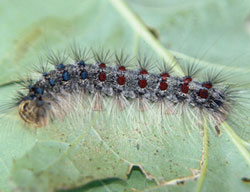
Late instar Spongy Moth larva
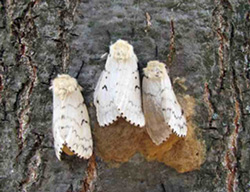
Female Spongy Moth laying eggs
What You Can Do
Residents are encouraged to monitor their hardwood trees like oaks, maples, beech and walnut for the presence of larvae.
Handpicking caterpillars is still one of the most effective ways to help control Spongy Moth on small, newly planted trees, shrubs, and plants. If possible, you can also gently shake the tree, so caterpillars fall from the leaves.
Thoroughly inspect the remaining foliage, branches, and trunk for caterpillars, and using gloves, pick them off your tree. Fallen and collected caterpillars should be placed and left to soak in soapy water.
What do the caterpillars look like?
The caterpillars of Spongy Moth are dark and hairy. They have five blue dot pairs and six red dot pairs on their back. They go through four to five "molting" events where they shed their skin and each time, they get bigger.

You can apply a product that contains BTK (Bacillus Thuringiensis “kurstaki”) to foliage at the early stage of caterpillar development when caterpillars just begin feeding. This is usually around mid-May. The pesticide must be ingested by the caterpillar to be effective.
For small trees and shrubs that are easy to access, products like Safer® Brand Caterpillar Killer can be purchased at local garden supply stores.
By mid-June, once Spongy Moth caterpillars grow to about an inch (2.5 cm) in length, they move down the trunk of the tree to seek shelter from predators and heat. You can trap the caterpillars on a burlap cloth to reduce the population.
Step-by-Step Instructions
- Wrap and secure a piece of burlap cloth around the trunk of your tree
- Tie twine or rope around the center or slightly below the center of the burlap
- Drape the burlap cloth over the twine or rope so there is an overhang where the caterpillars can crawl underneath to seek shelter during the day
- Check the trap by lifting the overhanging burlap cloth every afternoon and collect any hiding caterpillars
- Collect and put the moths in a container of soapy water and leave them for 2-3 days, then dispose of the contents.
Step-by-Step Instructions
- You can purchase the traps at various retail stores or online throughout your area
- Put the traps out when the moths are active after coming out of their pupa stage of growth. Only male moths are attracted to the traps.
- Homemade traps can be created with various designs found on websites. The traps have a bait inside their lid that smells like female Spongy Moth pheromone for attracting males.
- Once captured, put the moths in a container of soapy water and leave them for 2-3 days, then dispose of the contents.
Survey your property for egg masses and scrape them off surfaces into soapy water to destroy them.
Step-by-Step Instructions
- Place your catchment container below the egg mass
- Use your scraper tool to remove the egg mass from the surface. Ensure that all eggs
- are scraped. Try not to leave any residual eggs in bark ridges or crevices.
- Empty the contents of your catchment container or bag into a bucket of soapy water
- Leave the eggs sitting in the bucket for 2-3 days, then dispose of the contents.
Egg masses can be located high up in trees. Care needs to be taken if trying to access anything aloft, especially if using ladders. Some private tree care companies can be hired to provide this service at heights.
What the City is Doing
The City surveys and monitors populations of Spongy Moth and consults with government agencies and local municipalities to determine appropriate treatment programs that is dependent on Spongy Moth population levels.
The City’s Spongy Moth control program has been in place since 2008 and the program goal is to reduce Spongy Moth population level to below 2,500 egg masses per hectare. This program is not intended to eradicate Spongy Moth entirely.
Treatment options that have been previously undertaken include burlapping trees, aerial spraying, targeted ground spraying and egg mass collection. The product used in the spray program is an organic bio-pesticide that targets Spongy Moth and other caterpillars, and does not affect humans, pets, other animals, or bees. To learn more about the product used, see the Health Canada Btk Fact Sheet.
Public notice is always provided ahead of any treatment program being initiated.
The Emerald Ash Borer is a highly destructive invasive beetle that infests and kills ash trees. Ash trees are native to Ontario and were once popular trees found on City streets, woodlots and forests. Since first arriving in Canada in 2002, EAB has killed millions of ash trees in North America and has killed most of Hamilton’s ash tree population.
What the City is Doing
EAB was first detected in Hamilton in 2009 on the Hamilton Mountain. In 2012, the City launched a 10-year proactive management strategy to manage publicly owned ash trees, infested with the EAB, within the right of way in the urban boundary and in City parks and cemeteries.
Over the 10-year period, EAB damage to the ash tree population was significant City-wide, with most ash trees dying or declining to the point they required removal to mitigate risks to public health and safety.
Over the 10-year period, a total of 25,355 ash trees were removed and 27,905 replacement trees planted.
While the management strategy has concluded, treatment of ash trees that were preserved and removal of diseased and dying ash trees will continue as part of regular Forestry operations.
It is expected that EAB populations will continue to be present in Hamilton due to regenerating ash trees, and any remaining ash populations in naturalized areas, on private properties across Hamilton, and remaining publicly owned rural ash trees that have yet to be removed.
What You Can Do
If you have an Ash tree on your property that you think is infested with EAB, the first step is determining if that Ash tree is on private or public property (link to Tree Ownership and responsibilities webpage).
If the tree is on public property, call 905-546- 2489 to have your tree assessed by the City. If the City determines that the tree requires removal, the City will remove the tree and stump and will plant a replacement tree.
If the tree is on Private Property, it is your responsibility to maintain the tree, including removal if you suspect that the tree is infested. If you are unsure, you can hire a Tree Service Company to inspect and remove the tree, if required.
The Emerald Ash Borer spreads naturally through beetle flight; the beetle is capable of flying distances of 5 km in search of a host tree. The Emerald Ash Borer is also spread by people moving material infested with the beetle such as firewood and nursery stock.
Mountain Ash is not in the same family and is not affected by the Emerald Ash Borer. An Ash tree typically has:
Ridged Bark
On mature trees, bark is tight and displays patterns of diamond shaped ridges. On young trees, bark is relatively smooth.
Compound, Opposite Leaves
Leaves contain 5 to 11 leaflets with smooth or toothed margins (tips). Leaflets are positioned opposite with one at the top.
Seeds
When present, seeds usually hang in clusters and are oar shaped.
Opposite Branches
Branches and buds are directly across from each other rather than staggered. However, it is possible that not every branch will be opposite.
Emerald Ash Borer larvae feed underneath the bark and block nutrients and water from moving through the tree. The tree may be dead within a few years of the initial infestation. Infested ash trees often exhibit the following symptoms:
Crown Dieback
Severely attacked trees may exhibit crown dieback as the canopy dies from the top down. Leaves may wilt or turn yellow during the growing season.
Bark Cracks
Vertical splits of 7 - 10 cm are often present over larval galleries. These are often more noticeable on young trees that do not already have splits from growth-related expansion.
Woodpeckers
Woodpeckers feed on the larvae under the bark. Look for increased Woodpecker feedings.
Exit Holes
Once fully mature, the adult beetles emerge through exit holes they chew through the bark. These holes are distinctly D-shaped and are 3.5mm to 4 mm across.
Tunnels
Winding S-shaped larval tunnels snake under the bark where larvae bore channels. Removing the bark exposes larvae and sawdust-filled galleries.
The young larvae of Fall Cankerworms feed on leaves of host trees and can defoliate the entire tree. When cankerworm populations are large, larvae in search of food can drop silken threads and become a nuisance around homes.
While alarming, a mature, strong tree can survive one to two seasons of complete defoliation. That said, more than three years of defoliation from cankerworm feeding can potentially kill branches.
Preferred host trees include Manitoba Maples, Elm, and various fruit trees, however Fall Cankerworm can also attached Basswood, Burr Oak, Aspen and White Birch.
What You Can Do
Tree banding is an effective method of controlling Fall Cankerworms. Adult female cankerworm moths are wingless and need to crawl up the trunks of trees to lay their eggs. Tree bands trap the adult moths as they are crawling up the tree.
You should band your trees from late March to mid-May and again from early September to mid-November to catch the cankerworms moths at both the times they are emerging from the soil.
It is important to band all trees in an area or else cankerworm larvae could move from unbanded trees to banded trees. Please do not leave bands up longer than recommended as it can do more harm than good to the tree.
Banding a tree takes just three steps:
- Wrap a 10-15 cm (4-6 inch) wide strip of fibreglass insulation around the trunk approximately 1.5 m (5 ft) off the ground.
- Cover the insulation with cling wrap. Be sure to wrap it tightly so that the insulation is pushed into the crevices of the bark and to leave a bit of plastic above and below the insulation. This may take two or three layers of cling wrap.
- Spread a layer of petroleum jelly or a similar sticky substance on the plastic in a band about 10 cm (4 inches) wide.
What the City is Doing
The City, in conjunction with the Canadian Food Inspection Agency (CFIA) and other agencies, monitors Fall Cankerworm populations, and distributes and provides relevant information for suspected cases.
Hemlock Woolly Adelgid (HWA) is a destructive aphid-like pest that attacks Eastern Hemlock, an ecologically significant tree species in eastern Canada. It feeds on the base of the needles, causing needle drop and tree mortality in as few as 4 years.
HWA can be identified by its egg sacs, which look like cotton balls or clumps of snow, and can be found at the base of needles.
What You Can Do
- Avoid placing bird feeders near hemlock trees – birds can accidentally transport HWA to new locations.
- Don’t move firewood! Human movement of wood products increases the spread of HWA.
- In the spring, keep an eye out for signs, such as woolly egg masses, on your hemlock tree and report any potential sightings.
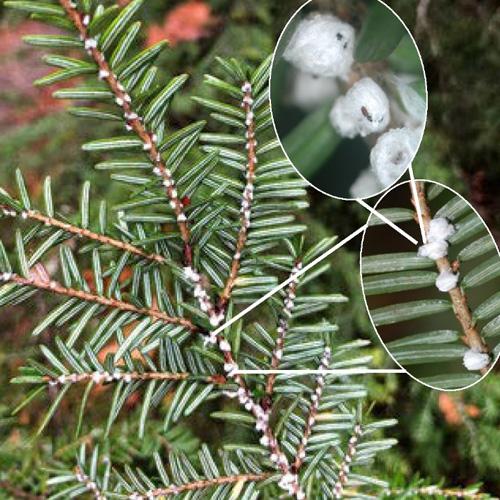
Photo credit: Natural Resource Canada; CFIA
If you believe you have identified HWA on your property contact your local Canadian Food Inspection Agency (CFIA) Office at 905-572-2201 to have an official identification. You can also report a potential invasive pest on the CFIA website.
If you have identified a potential HWA population on a street tree or a tree within a City of Hamilton Park or Cemetery, please call the City of Hamilton Contact Center at 905-546-2489.
What the City is Doing
The City, in conjunction with the Canadian Food Inspection Agency and other agencies, monitors and reports on suspected HWA sightings.
Spotted Lanternfly (SLF) is an invasive insect that kills plants and trees by sucking the sap from leaves and stems. SLF feeds on over 70 species of trees and plants, including cultivated grapes and fruit crops, and poses a threat to Canadian wine, fruit, and forest industries.
SLF has not yet been detected in Canada, but was identified in Buffalo, New York near the Canadian border in September 2022.
What You Can Do
Review the Fact Sheet to learn how to identify SLF.
If you believe you have found SLF or its egg masses, seal them in a container and immediately notify the local Canadian Food Inspection Agency (CFIA) Office at 905-572-2201 to have an official identification. You can also report a potential invasive pest on the CFIA website.
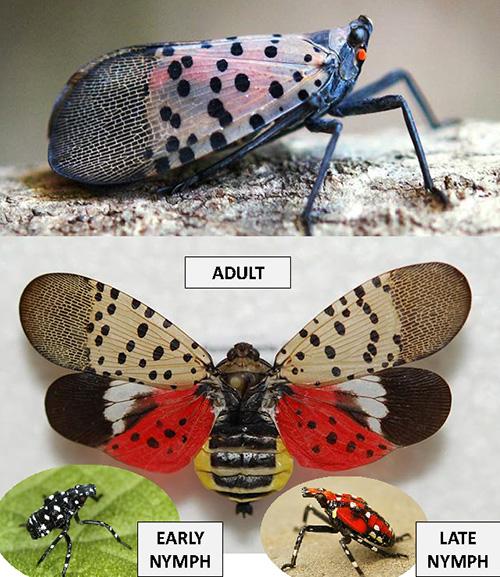
Photo credit: CFIA
If you have identified a potential Spotted Lanternfly on a street tree or a tree within a City of Hamilton Park or Cemetery, please call the City of Hamilton Contact Center at 905-546-2489.
What the City is Doing
The City, in conjunction with the Canadian Food Inspection Agency and other agencies, monitors and reports on suspected SLF sightings.
Oak wilt is a vascular disease of oak trees caused by a fungus that grows on the sapwood of oak trees that restricts the flow of water and nutrients. Some oak trees are more vulnerable and can die within a year of infection, and in some severe cases, mortality can occur within 2-6 weeks following infection.
In June 2023, the presence of oak wilt was confirmed by the Canadian Food Inspection Agency in Niagara Falls, Ontario. This is the first known case of this vascular disease of oak trees in Canada.
Signs and symptoms
- Sudden leaf wilting.
- Premature leaf drop, beginning at the top of the crown.
- Brown veins in the leaves mixed with normal green tissue.
- Vertical cracking in bark.
- Grey or tan mats of fungus under the bark of an infected tree.
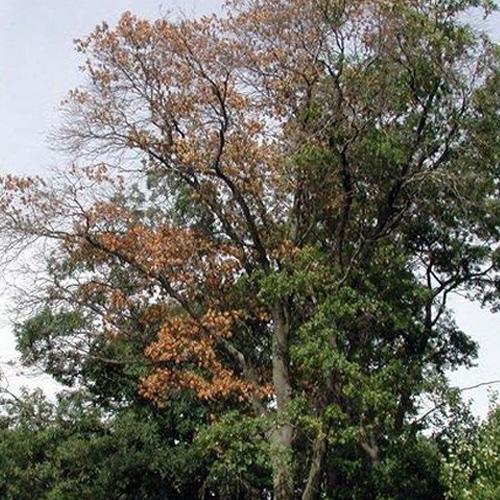
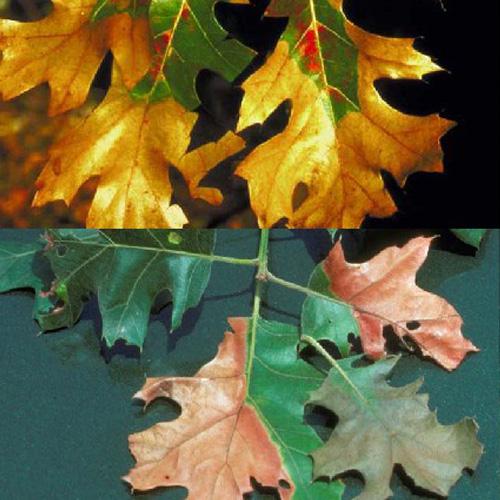
Photo credits: CFIA, Arborjet, and USDA Forest Service
What You Can Do
Oaks that belong to the group of red oaks (pin oak, black oak, northern red oak) are more susceptible than white oaks (white oak, bur oak, swamp white oak). There is no way to save an infected oak tree; the only way to deal with oak wilt is prevention.
- Don’t Move Firewood! Buy where you burn it or buy certified heat-treated firewood. Check with parks or campgrounds before you go for rules about firewood.
- Since the fungus enters the tree through wounds, refrain from cutting, pruning, harvesting or injuring oak trees on your property between March until October. Be careful maneuvering around oak trees with your lawnmower and other power tools.
- Learn to identify oak trees on your property and become familiar with signs and symptoms.
Review the Fact Sheet to learn how to identify Oak Wilt
If you believe you have identified oak wilt on your property contact your local Canadian Food Inspection Agency (CFIA) Office at 905-572-2201 or email [email protected] to have an official identification. You can also report a potential invasive pest on the CFIA website.
If you have potentially identified oak wilt on a street tree or a tree within a City of Hamilton Park or Cemetery, please call the City of Hamilton Contact Center at 905-546-2489.
What the City is Doing
The City, in conjunction with the Canadian Food Inspection Agency and other agencies, monitors and reports on suspected Oak Wilt sightings.
Don’t worry, it is a very common thing to get yellow or black spots on your maple tree leaves. This is caused by a fungal disease, also known as Tar Spot. Tar Spot makes trees look unpleasant, but is rarely harmful enough to affect the health of trees, through heavy infections can cause early leaf drop.
What You Can Do
A variety of factors contribute to the spread and recurrence of this fungal infection. Some factors, such as weather, are not able to be controlled. However, there are some ways in which you can help to prevent infection.

Proper garden and yard sanitation will help reduce the spread of tar spot.
- In the fall, remove all infected leaves by bagging or composting them to eliminate the closest source of tar spot spores. If you leave the fallen leaves on the ground until spring, the spores on them will likely reinfect the new foliage and start the cycle again.
- Eliminate standing water around infected trees as trees that get the fungal disease year after year may be struggling with excessive moisture.
- Treat young maples trees. If you’re planting a young maple in an area prone to the fungal disease, you can apply a fungicide such as:
- Safer Defender Garden Fungicide 1L Ready-to-Use or Safer 3-in-1 Garden Spray 1L Ready-to-Use, at bud break and twice again in seven-to-fourteen-day intervals.
- Once your tree is well-established and too tall to easily spray, it should be able to fend for itself.
Additional Resources
- Invasive Species Centre (ISC) provides educational resources, grant opportunities, and hosts
events and programs for invasive species awareness across Canada. - Canadian Food Inspection Agency (CFIA) is the federal regulatory body that mandates
legislative action against invasive species. - Ontario’s Invading Species Awareness Program provides resources and coordinates initiatives for
invasive species found in Ontario. - EddMapS is a tool used to map the spread of invasive species across Canada, the US, and parts
of Europe. Members of the public and researchers can report a sighting or view confirmed
locations of invasive species.






